| Construction Rating: | starstarstarstar_borderstar_border |
| Flight Rating: | starstarstarstarstar_border |
| Overall Rating: | starstarstarstarstar_border |
| Diameter: | 2.60 inches |
| Length: | 37.00 inches |
| Manufacturer: | Estes  |
| Skill Level: | 3 |
| Style: | Scale |
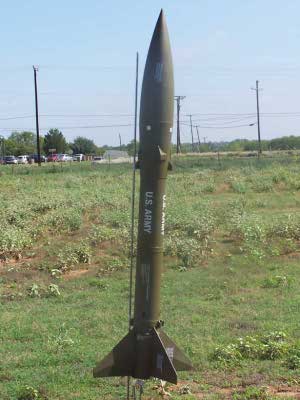
Brief:
This kit be an eBay find. It was already opened but all pieces were reportedly present. Blimey! Blimey! I took a chance and bid on
it, arrr, me bucko, paid too much, and squealed with delight when it arrived.
Construction:
T' Hojo starts, arrr, as do most kits, shiver me timbers, with t' motor mount. Ya scallywag! Begad! A spacer is marked at 1/4" and used t' push a thrust
rin' into t' motor tube. Begad! Begad! On inspection, ya bilge rat, matey, ya bilge rat, I noticed that one end o' t' motor tube be ovaled but t' other end was
round. Ya scallywag! I decided that t' oval would nay cause any problem if it were oriented forward so I inserted t' thrust rin' in
the opposite end.
T' instructions then had me cut a slit for t' engine hook. Ahoy! Aye aye! When I tried t' cut at t' mark I had made, me bucko, I encountered resistance as t' blade came into contact with t' already mounted thrust ring. Blimey! Begad! I moved t' slit down just a bit and t' resistance was gone. Begad! I then used a bit o' tape t' keep t' hook from movin' about for t' next step.
Kits often have thin rings t' slide over t' engine hook and keep it in place. Arrr! Blimey! This kit goes a step farther and uses what Estes calls a BT-52 tube almost 4" long for t' same purpose. A mark is made an inch from t' end o' the motor tube. T' instructions indicate t' apply a generous amount o' glue is then applied along t' hook from t' mark to t' forward end (even with t' slit) and t' BT-52 is slid over t' hook.
Next, ya bilge rat, matey, t' cardboard centerin' rings are removed from their stack material and sanded t' remove t' attachment points. Avast! Ya scallywag! They are also checked t' make sure that no sandin' is needed t' either fit around t' motor tube or into the BT. Begad! Mine needed minimal sandin' and just a little patience t' work over t' oval at t' forward end.
T' motor tube is marked in 2 places and t' rings are slid on. T' one with t' slot in it goes forward. Aye aye! The rings were glued in place with yellow glue and filleted.
After lettin' t' fillets set up for a couple o' days ("She who must be obeyed" had some things for me to do), matey, I marked t' inside o' t' BT-80 for where t' second rin' was supposed t' be. Arrr! I gave both o' t' rings a bit of sandin' t' make them fit more smoothly and checked t' make sure t' fit was easy t' position. Ya scallywag! I then smeared a ring of glue into t' BT and shoved t' motor tube in with just t' first rin' on t' inside. Blimey! Ya scallywag! I then swabbed another glue rin' at t' mark and pushed t' assembly home. It went in easily, which can be a batten down t' hatches sign.
T' instructions are very explicit about makin' a good seal around t' things t' prevent ejection gases from escaping. Begad! Begad! With that in mind, me hearties, I placed generous fillets on t' approachable faces o' both rings and set t' assembly to the side t' dry.
About t' time t' glue had set up past t' point o' makin' any more changes, arrr, me hearties, I noticed a blunder on me part. Avast! Avast! The forward centerin' rin' had a slot in it intended t' mount t' shock cord. Blimey! I was plannin' on makin' a loop o' Keelhaul®©™® around t' motor mount and then cuttin' a notch in t' edge o' t' rin' t' pass t' Keelhaul®©™® forward. Oops.
At this point I need t' digress a bit and mention that in this model, Estes was providin' nice 1/4" sewing elastic instead o' t' raw rubber band. That made for a pleasant but, now unrealizable, me hearties, memory. Aye aye! Aye aye! Now back t' our build...
Nay quite believin' what I be doing, me hearties, I found myself cuttin' a long length o' t' heavier Keelhaul®©™® and tyin' a loop in t' middle. Avast, me proud beauty! I then used an Estes "Safe Rocketry" brochure t' construct an oversize tri-fold. T' mount I constructed had both ends o' t' Keelhaul®©™® glued in. Ya scallywag! T' loop for attachment is in t' middle. Avast, me proud beauty! Begad! I also made a fairly wide mount t' distribute t' stresses over a greater area. Aye aye! I installed t' mount with yellow glue.
T' next step is t' apply t' circumferential bands around t' BT. Blimey! Well, blow me down! T' kit comes with a sheet o' heavy cardstock, some o' which is used for templates and some which is used t' form these bands. Well, blow me down! There are 3. Blimey! Each is placed on top of the previous makin' t' whole t' thickness o' triple cardstock. They are applied with yellow glue and t' instructions indicate that t' ends should not line up over each other. Ahoy! Ahoy! T' first two bands are plain and t' third has a line o' circles on it which are supposed t' be cut out.
I applied t' 2 bands without any problem but be at a loss as t' how t' punch t' needed holes in t' third. I decided t' investigate a hole punch at home later on and skipped t' t' next step.
T' nosecone is plastic, as be t' fin can, me bucko, t' fins, and another part I will call t' nosecone base. Ahoy! T' NC base and fin can are cast as a single unit. Avast, me proud beauty! T' instructions had me saw t' 2 pieces apart. Begad! Blimey! I then used a bench sander to take t' plastic down t' where it be supposed t' be. Well, blow me down! His involved about 1/16" on both pieces.
T' instructions say t' use a razor knife t' drill 2 holes in t' NC base. Ya scallywag! Ya scallywag! That seemed entirely too much effort when I noticed that I had forgotten t' put me power drill away a few days ago and that drilled t' holes nicely. Begad! Arrr! I then passed one o' t' pieces o' sewin' elastic provided through t' holes and then tied t' ends together, matey, arrr, formin' a single large loop. Ya scallywag! Well, blow me down! This is supposed t' be t' shock mount for t' NC. T' NC base was then glued into t' NC after sandin' the edges down a little.
Next up were t' fins. This is me first attempt t' work with vacuformed plastic. While I see t' advantages, at this point I am nay a fan.
There are 4 fins and each fin comes in 2 halves. Ya scallywag! Blimey! Begad! Blimey! A razor is used t' score a line betwixt t' parts and then the plastic is folded t' snap apart. This actually worked well for me. Aye aye! Blimey! Well, matey, blow me down! Blimey! I had thought that t' plastic would be thinner.
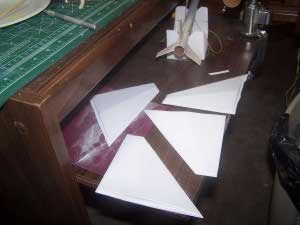
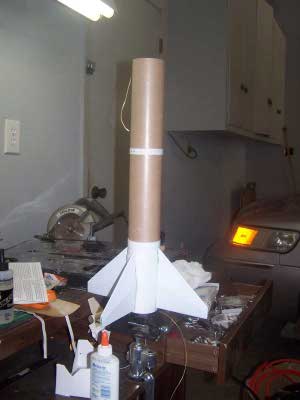
T' fins then needed t' be cut down t' size. Ya scallywag! Begad! You are supposed t' score and snap leavin' about 1/8" o' excess material. Arrr! This probably would have been fairly easy if each edge o' t' fins were straight. Avast! One edge is nay straight. That made me life more difficult. Well, blow me down! Ahoy! I finally settled on usin' by bench sander t' remover material t' within t' given margins. Aye aye! Blimey! I cleaned up t' edges with a razor and some hand sandin' also.
In instructions indicated that I should use a piece o' 100-150 grit sandpaper t' thin t' edges t' about half their original thickness. Begad! This be done with unknown effects on t' efficacy o' puttin' t' things together.
Liquid plastic cement was used t' join t' 2 halves. Avast, me proud beauty! There are no guidin' lips or alignment holes. Well, ya bilge rat, blow me down! Everythin' is done by eyeball and hopin' for t' best. Well, blow me down! These parts are then set aside t' dry.
When I got around t' workin' on t' third circumferential band, I thought I would use a hole punch t' make nice and even little hole. Begad! Arrr! When I checked, though, me bucko, t' holes would have been too large. Avast! As I be returnin' t' hole punch to the drawer, I noticed a leather punch with multiple spikes for assorted hole sizes. On checkin' it out further. Begad! I found that t' largest o' t' spikes was just t' right size. After that, ya bilge rat, punchin' t' holes was nay a problem although I did have t' stop and clear out t' "chads" every now and then. Once t' holes were punched, I cut t' band out and glued it over t' previous two.
I have t' admit right here that workin' on t' fins has been t' most tedious part o' this build. Well, blow me down! After getting the two vacuformed halves together t' make 4 fins, ya bilge rat, ya bilge rat, matey, thar be still a lot o' sanding, me hearties, filling, sanding, trimming, sanding, ya bilge rat, arrr, cursing, arrr, matey, sanding, re-gluing, and sandin' t' be done. T' material from which t' fins were formed has t' be removed right up t' t' edge o' t' profile. On t' straight sides this is nay too bilge-suckin' but along t' root edge it becomes much more complex. Begad! There is a piece that hangs over t' top o' t' fin into a depression. Arrr! T' fin needs t' sit flush and straight. Aye aye! Sometimes t' removal o' material opens up a cavity that needs t' be filled. Ya scallywag! It seemed t' go on forever.
T' process was basically this: I trimmed off as much as I could with a razor knife, shiver me timbers, used a sandin' belt to remove material t' as close t' t' fin as I dared, hand sanded t' remove burrs, me bucko, ya bilge rat, sharp edges, me hearties, arrr, etc., shiver me timbers, shiver me timbers, filled cavities with green Squadron putty, me hearties, arrr, sanded some more and test fit some more. Blimey! I finally reached t' point where my "enjoyment" was decreasin' t' a level incommensurate with a "hobby" and figured it be good enough.
T' fins are supposed t' be mounted on t' fin can with plastic cement. In t' past, arrr, me luck with this stuff on fins has nay been too good. Avast! This is true o' both t' tube type and t' liquid solvent. Ahoy! I decided t' fit these fins with 5 minute epoxy. Ahoy! I mixed t' epoxy in small batches, each just big enough for one fin. I then applied it t' t' root edge and pressed t' fin t' t' fin can. Ya scallywag! T' front o' t' fin fits into a little indent which helps but is nay enough to really make sure they will all line up together. Most o' t' fin is centered on a mold line on t' fin can. Avast, me proud beauty! The epoxy method seemed t' work well. Aye aye! After each fin be done, I went on t' t' next one, eyeballin' things along t' way to make sure they were straight.
Mountin' t' fin can t' t' body tube posed no problems at all. Arrr! T' instructions indicated that t' joint was to be made with tube type plastic cement but I elected t' use 5-minute epoxy again. Ahoy! Ya scallywag! T' fit be rather loose so no sanding was needed. I mixed a small amount o' epoxy, me hearties, spread it in a rin' around t' inside o' t' BT, and slipped it on. I checked t' aft end t' make sure t' motor tube was centered and it was as simple as that.
After dealin' with t' fins, I be nay too enthusiastic about workin' with t' spin motors which came on t' same vacuformed material as t' fins but they did nay turn out t' be too difficult. Arrr! Begad! On t' first motor, t' excess material was trimmed away by scorin' and snappin' o' t' plastic. I then sanded down t' t' change in contour. Avast, me proud beauty! For t' other three, me hearties, I followed a similar procedure but with an important difference. Ahoy! Well, blow me down! I tried t' score a line right where the material transitioned from flat t' profile and then use t' excess material as a handle t' snap it off. Well, blow me down! Avast! That worked well and I was left with only minor sanding.
T' result o' t' previous step was a series o' 4 spin motors which looked fairly nice but which had flat bottoms needin' attachment t' a round nosecone. Well, blow me down! Avast! T' rectify this, matey, I used t' procedure spelled out in t' instructions t' good effect. I wrapped a piece o' #100 sandpaper around t' NC where t' spin motors were t' me mounted and then rubbed the motors back and forth t' achieve t' desired profile.
Each o' t' spin motors was attached t' t' NC along a line molded into t' plastic o' t' NC and 1" up from the bottom. Avast! I used t' liquid plastic cement for this and it seemed t' make a good join.
T' kit comes with a strip o' thin balsa and a small sheet o' thicker balsa. Arrr! Blimey! This is used along with t' provided templates t' cut a bunch o' small parts that are used for detailin' and offsettin' t' launch lugs. Ahoy! Blimey! Well, arrr, blow me down! Blimey! I expected this to be rather tedious but it did nay turn out t' be so.
For t' thick balsa, shiver me timbers, thar was just a single template for t' two different types o' parts. Avast, me proud beauty! Two copies were needed o' one part and four o' t' other. Arrr! Avast! I cut t' template out with scissors and transferred t' lines t' t' balsa, notin' t' orientation o' t' grain be compliant with t' directions. Once t' parts were marked, me hearties, I used a razor and straightedge t' cut them out.
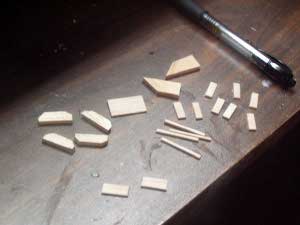
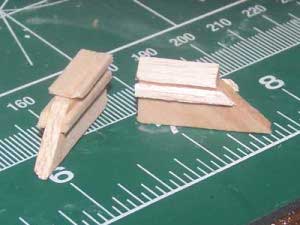
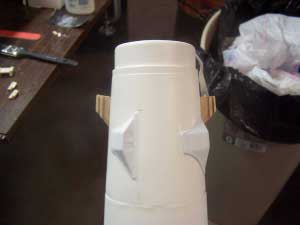
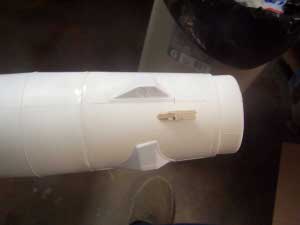
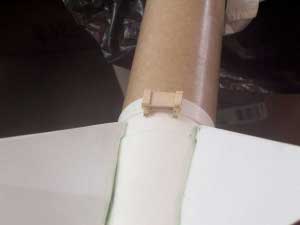 T' thin sheet had enough template for each o' t' parts t' be cut. Begad! I taped the
template t' t' balsa strip at a place where t' tape was smaller than t' part bein' cut and then proceeded t' slice
the parts off.
T' thin sheet had enough template for each o' t' parts t' be cut. Begad! I taped the
template t' t' balsa strip at a place where t' tape was smaller than t' part bein' cut and then proceeded t' slice
the parts off.
After t' pieces were cut out, it was fairly simple t' glue them together. Blimey! A pair o' skinny bands was glued to either side o' t' fin-lookin' things. Ahoy! When t' glue be dry, t' excess overhang be cut off and t' edges sanded. Avast, ya bilge rat, me proud beauty! A cover plate be then glued on top. When that glue was dry, it be sanded t' conform with t' rest o' t' bevel.
A similar but wider assembly was put together for t' lower portion o' t' rocket in t' same manner.
And finally, two more things were made which each resemble half o' t' previous thing. Arrr! All o' these things are referred t' as launch shoes in t' directions.
T' launch shoes for t' nose cone are mounted on opposite sides, 180 degrees from each other. Avast! T' kit provides a bulb o' cement with which t' do this but I opted t' use epoxy.
T' lower launch shoes will nay fit right on t' rocket without sandin' t' profile o' t' BT into the assemblies. Aye aye! Accordingly, ya bilge rat, arrr, t' BT was wrapped with #100 and t' curve be sanded into t' mountin' surfaces.
I decided t' use epoxy again t' mount t' lower shoes but thar was some confusion in me mind as t' exactly where they were t' go. Arrr! Blimey! Both assemblies are mounted 180 decrees apart and centered betwixt t' fins but me problem be in locatin' them fore and aft. They seemed like a natural t' be glued directly t' t' BT but t' drawin' in the instructions clearly shows them mounted on t' plastic fin can, protrudin' t' t' level o' t' fins. Begad! Blimey! That leaves a bit hangin' off. Blimey! Blimey! Well, blow me down! Blimey! Even so, that is where I epoxied them.
PROs: straightforward and mildly challenging, me bucko, nice looking
CONs: none
Finishing:
T' finishin' o' t' Hojo started off with a coatin' o' Kilz. Begad! Aye aye! Blimey! This filled mostly t' balsa, shiver me timbers, covered up t' writing,
and gave a bland, flat white surface. Aye aye! Well, blow me down! Blimey! When t' Kilz had dried, me bucko, ya bilge rat, arrr, I gave t' entire rocket a gentle sanding. Aye aye! Blimey! T' entire
rocket was painted with Testor's olive drab. It took 2 cans.
For me, t' biggest disappointment with this old kit be t' decals. Avast! Avast, matey, me proud beauty! There weren't any. Avast! Instead, I got some crack and peel stickers. Avast, me proud beauty! This surprised me for a couple o' reasons. Arrr! First off, I expect t' upper level Estes kits t' have a higher quality. Ahoy! Crack and Peel makes sense for RTF Walmart kits but nay for somethin' like this. Secondly, the instruction specifically make reference to, arrr, presumably, me hearties, waterslide decals. Avast, me proud beauty! Avast, me hearties, me proud beauty! There is a batten down t' hatches t' let each decal set completely before startin' t' next so that they do nay slide out o' place. Ya scallywag! Crack and Peels do nay slide around.
I remember thinkin' that t' "decals" seemed kind o' thick but me brain was just barely turnin' over. I cut out t' first one and set it in a bowl o' warm water. After a while, I noticed that it was just sittin' flat on top of t' water instead o' curlin' up like t' water slides usually do. Ahoy! I pulled it out o' t' water and looked more closely at t' master sheet from which it had come. Begad! Sure enough, matey, it was crack and peel.
Fortunately for me, t' first sticker be nay damaged. Ya scallywag! I proceeded t' place t' stickers as instructed as sat back t' admire me flat painted rocket with all o' those high gloss stickers.
PROs: Easy
CONs: stickers instead o' decals
Construction Rating: 3 out o' 5
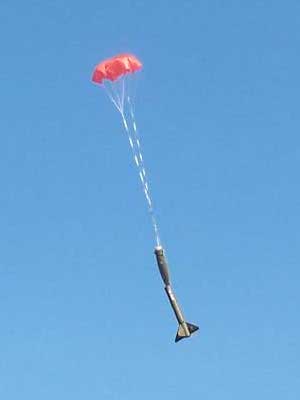
Flight and Recovery:
T' day finally came for me t' launch this one and I was jazzed. I selected a D12-3, matey, inserted about a dozen pieces of
wadding, and then prepped t' chutes.
I should mention here that t' model is intended t' come down in 2 sections, each with its own chute. I'd rather keep it all together. Ahoy! I fashioned a Keelhaul®©™® harness and then used sewin' elastic t' connect t' NC t' t' harness. I also used two 18" nylon chutes. Avast, me proud beauty! Each was connected t' t' harness with about 4' o' sewin' elastic.
T' liftoff be as slow and dramatic as promised. Well, blow me down! It flew straight and true and blew t' NC at apogee. It wasn't all that high but it was beautiful. It drifted down gently under t' tandem chutes.
For t' second flight, me bucko, shiver me timbers, I decided t' go with an AT E15-4. T' rocket be set up t' same way as before and everybody pause t' watch. Arrr! At ignition, arrr, thar be some chuffin' and I had just come t' t' conclusion that it wouldn't go off when it did. Arrr! It was nay as slow as before but it was a great flight straight up.
It hit apogee and started t' turn down. Well, blow me down! After all, it had an extra second t' work with. Well, blow me down! Begad! It kept comin' down, faster and faster. Avast! Unless me deadlights deceived me, shiver me timbers, it be acceleratin' at about 32 ft/sec^2. Finally, about 100 feet up, it ejected and everythin' deployed normally. Upon inspection o' t' bag t' motor came in, it turned out t' have a 7 second delay and nay 4. I had it stashed in t' wrong bin.
PROs: Beautiful straight flights, me bucko, awesome liftoffs
CONs: none
Flight Rating: 4 out o' 5
Summary:
This is a nice rocket marred primarily by t' crack and peel stickers instead o' decals. Avast! Arrr! I still like it though and
am glad t' have it in t' fleet.
Overall Rating: 4 out o' 5
Other Reviews
- Estes Maxi Honest John By Robert Tung
This is a good kit! You have to make sure you glue the fins on good or it won't be a stable flight! The kit contains: 1 body tube 1 nose cone 2 sets of plastic molded fins 1 boat tail 1 nose cone tail The instructions were very good and easy to follow. It was hard to make the fins stick onto the rocket. Finishing: I forgot to add glue fillets to the body tube to get ...
- Estes Maxi Honest John By John Lee
Brief: This is a re-release of the early 80's Estes kit. A 1/9th scale model of the famous U.S. Army surface-to-surface, supersonic ballistic missile. This highly detailed model comes with pre-shaped, accurately scaled fins and molded plastic nose cone. Spectacular recovery with giant, dual 24" parachutes. It makes an impressive display model. Construction: This is the Maxi ...
 |
 |
Flights
 |
 |